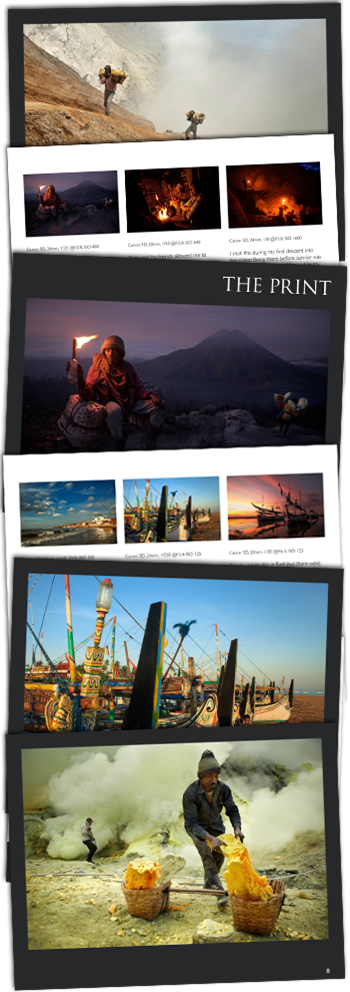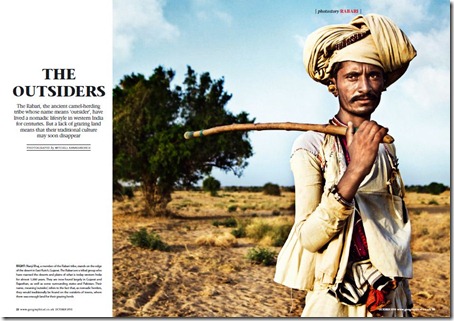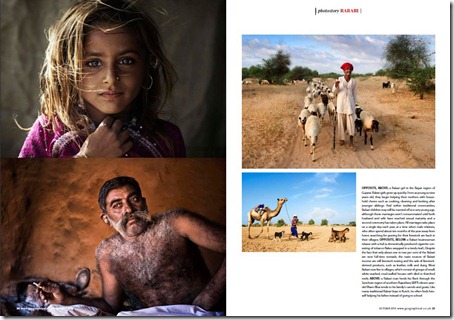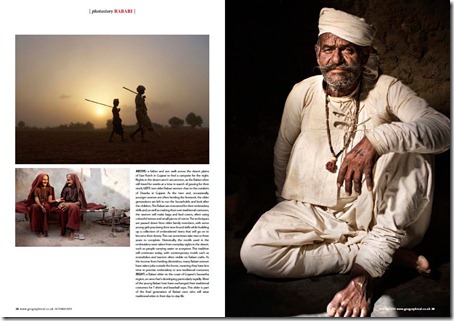Istanbul is the city of one hundred names, incredible historical importance and, a heaven for street photographers. Fujifilm X100S is the next amazing thing that the photo-world seems to be raving about these days. I found myself lucky enough to be in Istanbul, with that very camera and, here are my impressions of both, the city and, the gadget.
Treasures in the Rock Mountains
The climb takes around forty-five minutes and it is literally a climb using your hands and feet for the last part of the journey. Holes in the vertical rock surface are what you use to keep yourself from falling off and to get to the top. As The "Lonely Planet" guidebook says, if you're scared of heights, "Don't look down!" Having a panic attack or"freezing" here would not be a good idea.
Rabari - Encounters with the nomadic tribe, a new e-book
All Journeys Have to End
Just under two months in India and my Himalayan adventure has come to an end. As usual, time flew by very quickly and as usual I wish I could stay longer. I am tired though. This trip was intense in so many ways. Riding in the mountains does take a toll on the body and the motorbikes. Both “machines” have cracked chassis from the horrendous (but spectacular) Zanskar road.
New eBook - Journey Through Java
 Hello good people of the Cyberworld! I have a new eBook out! As you probably gathered from the image above, it’s called “Journey through Java”. This one is a collaboration with David duChemin’s “Craft and Vision” team and it is a part of their very popular “Print and Process” series. Basically, it’s my photos and words, their structure and design.
Hello good people of the Cyberworld! I have a new eBook out! As you probably gathered from the image above, it’s called “Journey through Java”. This one is a collaboration with David duChemin’s “Craft and Vision” team and it is a part of their very popular “Print and Process” series. Basically, it’s my photos and words, their structure and design.
Those of you who have been following my blog for some time are aware that I have known this duChemin fellow for a while. I think quite highly of the man, so when David approached me about doing one or possibly even a few eBooks for the “Print and Process” series, I said - “Sure thing mate!”
What really excites me about this eBook is the fact that the structure of it allowed me to focus on a specific stretch of time during my photographic journeys and as a result I was able to delve deeper into my photographic process than ever before. The eBook is fairly personal, but at the same time, the knowledge one should come away with is applicable on a very wide scale.
There’s talk about the equipment used, the technical aspects (every image has the Exif data provided) as well as composition and light. These things are all discussed in a very practical sense, as they relate to the images included in the eBook. There is a somewhat philosophical side to what I’ve written too. In this eBook I really wanted to touch on what makes a photograph more than a snapshot or an overused cliché and so I’ve devoted a whole section to the discussion of what it means to create shots that are deep, original and express what the photographer feels to the fullest.
Who is this eBook for? It is for anyone who enjoys my photography and wants to know how I go about creating my work. I do however feel that the eBook will be particularly useful for the serious amateurs who want their photos to be more than “pretty pictures” as well as those thinking of doing travel and documentary photography for a living.
The really good part for all of you strapped for cash is - it’s only $5! And if you use the promotional code JAVA4 as you check out from Paypal, you’ll get it for $4 (offer expires 11:59pm PST October 3, 2010).
To purchaseor for more info, head over to the “Craft and Vision” site HERE or click the cover shot at the top. As always, your support is really appreciated!
I’m still in Port Villa as I write this, but heading home soon. More photos and hopefully some videos to come soon.
When hard work pays off
 A couple of months ago I got an email from an editor of British Geographical magazine telling me that my submission for a photo story on the Rabari (which I had actually submitted a year ago) was to be printed in the October issue of the magazine. A few days ago, when I returned from another trip to a remote part of Vanuatu I also received the news that they'd be using my image on the cover. Good news, I say, but let me share a little story that might be useful for some of you interested in having a career (if there's such a thing) in travel photography.
A couple of months ago I got an email from an editor of British Geographical magazine telling me that my submission for a photo story on the Rabari (which I had actually submitted a year ago) was to be printed in the October issue of the magazine. A few days ago, when I returned from another trip to a remote part of Vanuatu I also received the news that they'd be using my image on the cover. Good news, I say, but let me share a little story that might be useful for some of you interested in having a career (if there's such a thing) in travel photography.
In 2007 I travelled around West India along with my wife (then girlfriend) Tanya and my close Gujarati Indian friend Hardik. Our journey lasted for almost half a year. The aim of the journey was to photograph some of the last of the traditional Rabari people – the nomadic shepherds who have roamed the area for almost an entire millennia.
That particular journey was one of the most gruelling and challenging journeys of my life (ok, so I am not that old, but still). It was so difficult partly because it was the first serious project of my photographic career, partly because I had a motorcycle accident half way through and was very limited in movement for over a month, partly because the consequence of my limited movement made the project drag into the ridiculously hot months of West Indian summer (it got to 45C every single day) and finally it was difficult because the traditional Rabari were not all that easy to find, a lot of our time was spent on “field research”, arriving at certain destinations and having to ride (a motorcycle) hundreds of kilometers in some other direction because what we were looking for wasn’t there. I literally put blood, sweat and tears into that project, in fact so did Tanya and Hardik.
The project was funded by my previous print sales, cash from a wedding shoot that I'd done, some unemployment money I was able to save, as well as money I’d earned by working a few months in a photographic store just before the trip. Those were the days of struggle that undoubtedly all of us in the photographic profession go through at some stage (and I can only pray that I won’t have to go through them again).
The sole idea that I had for the images after the project would be finished was to have an exhibition. I was naive, thinking that an exhibition in Sydney could lift my status from a photographic nobody to somebody who could at least get an opportunity to keep making money doing what he loves. Perhaps I'd make a whole bunch of cash through print sales or somebody would notice my talents and hire me to shoot something, I thought. The outcome of the exhibition was a bit of a mixed bag. It was very successful in the sense that a lot of people came through the doors and saw my work, I even got some small critical appraise. However, it was a total failure as far as solving my financial problems – I sold three prints and one specially made album, which cost almost as much to produce as I sold it for. The cost of the exhibition and printing far outweighed the income I generated. I didn’t get a photographic job nor was I commissioned to shoot anything as a result of the exhibition either and so, by the end I felt a little doomed, like I was destined to go back to work in that photo store and to shoot weddings (no offence to those who do it professionally, it’s just not my thing).
Being fairly optimistic (and still naive), I didn’t let those thoughts pull me down for too long though. I realized that I was still at the very beginning of my journey and I had done something important - I laid a foundation for something good. Photographically it was very important that I had created a body of work that I could be proud of. I have always been and still am a firm believer in that for a photographer (especially at the start the journey) the goal of creating strong work should precede anything else. In the beginning a photographer should work for his photos and as the photographer’s career progresses the photos start working for him/her. This was the case with the Rabari project and the latest publication in Britain’s Geographical magazine serves as a nice reminder of this belief that I have.
The publication comes over three years after the project was finished and there were numerous others in between. While the exhibition didn’t help me achieve what I wanted, the result or lack of it gave me a good kick up the backside. I understood that my work wasn’t done and began to contact numerous magazines and entered into various competitions. The most notable of the results was me winning Australia’s Capture Magazine’s competition for best young photographer of the year for a selection of images from the project ( I got a $2000 camera as a result and sold it on eBay to help fund more future travels). Besides that I won a few other, smaller competitions for select single images and was published in quite a few photographic magazines (through which I sold more prints), one of which was the magazine where Kym, the enthusiast photographer who ended up going on my workshop in India (which I really enjoyed) found me. I have also licensed a number of the images from the series for various uses. All in all I have been rewarded quite well for my work, the rewards weren't instant, but they certainly came.
And so, what's the lesson here? There are a few of them, the first is that rewards do not always come in the shape or form that one expects them to. The exhibition, which I had put so much hopes into was nice in some ways, but the bigger rewards as far as exposure to a wider audience and income came from places I hadn't even really thought of. The next lesson is that creating a project or a series of images which can be used for various purposes seems to be the way to go these days. Don't put all of your eggs into one basket, it’s not like you shoot something for a big magazine, have your big pay-day and off you go on a spending spree, I have personally only heard of those days from some old-timers.
Above all that I have already mentioned though, I have written this blog post to remind and to encourage those talented photographers who might be a little discouraged with the way things are turning out for them or even feel totally lost at the moment. Remember the part about hard work. Remember also that creating truly worthwhile photography is what really matters at the end of the day. Remember that you might not be rewarded instantly, as I wasn't, but if you believe that your work is worth something, keep fighting for it, get it in front of editors, you don’t need any special connections or contacts for this, I simply sent emails and submissions to names I’d found on the internet or in magazines on the newsstands.
If you have put in the work, if you have something of value, you will eventually meet positive results – that’s the bottom line and that's the main point that I hope comes across from what I've typed here.
Ok, that’s about enough of that. The magazine goes on sale in October, probably only in the UK (though I may be wrong). Below are some screen grabs from the preview PDF which I was sent. I’m still in Vanuatu, but I am near the internet, so expect more posts and photos in the coming days.





